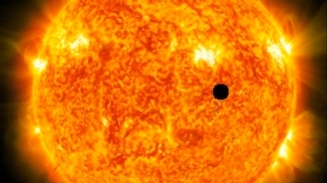
太空藏宝图
Space "Treasure Map" Guides E.T. Search
太空藏宝图
A pair of astrophysicists advise searchers of intelligent life to look in the narrow band of galactic sky from which any alien observers would see Earth transit the sun—a method we use to detect exoplanets.
两个天体物理学家建议,有关研究人员应在一条外星观测者可以看到地球经过太阳的狭窄星系带中搜索外星高等生物——这也是我们探测外行星的方法。
撰文:克里斯多弗 因塔利亚塔
翻译:惠丹丹
审核:邰伦玥
Carl Sagan once referred to our home planet as [CLIP: "a mote of dust suspended in a sunbeam."] And that poetic description holds true for a lot of exoplanets, too. In fact one of the simplest ways we detect exoplanets is by looking at their sunbeam… and measuring how it dims, ever so slightly, as the exoplanet passes across it, called a transit.
卡尔·萨根曾把地球称作“阳光下的悬浮的一粒尘埃”。而这具有诗意的描述也同样适用于很多系外行星。事实上,我们探测系外行星的最简单的一种方法就是观察它们的恒星的光,并测量在行星穿过光束时这些光是怎样慢慢暗淡下来、甚至消失的,这个过程叫做经过。
Which raises an interesting question: "Thinking about extraterrestrial observers—which of them would observe the Earth, moving across our own sun?" Ralph Pudritz, a theoretical astrophysicist at McMaster University in Canada. He and his colleague René Heller quantified the narrow band of space from which any observers on otherworlds would be able to see the Earth transiting the sun.
这引发了一个有趣的问题:“外星观测者是否也会在我们的地球经过太阳时观察地球?”加拿大麦克马斯特大学的理论天体物理学家拉尔夫普德里兹说。他和他的同事莱恩希勒确定了那些可以看到地球经过太阳的外星球所在的狭窄空间带。
And they determined that this line of sight would be a plane just half a degree thick, but that cuts through a slice of our galaxy that's estimated to contain 100,000 sunlike stars… along with their companion planets. The analysis is in the journal Astrobiology. [René Heller and Ralph E. Pudritz, The Search for Extraterrestrial Intelligence in Earth’s Solar Transit Zone (online soon)]
而且他们确定这一视角线是一个仅有0.5度厚的平面,但却经过了一片包含约100000个类日恒星和绕它们运行的行星的银河系。这一发现发表在天体生物学杂志上。
Pudritz and Heller suggest that hunters of extraterrestrial life may want to listen particularly closely for signals originating at star systems within that narrow band of galactic sky. Advanced civilizations there may have already detected us using the transit method, they say, and may now be sending us a message. You might think of this paper, then, like a treasure map, for intelligent life. "We don't know if there's treasure out there of course, right? You never know that about a treasure map. But it's a good place to look.”
普德里兹和希勒表示也许有成千上百的外星生命想要特别靠近地测听那个狭窄星系带中的行星发出的信号。可能存在的外星先进文明也许已经用经过方法探测到了我们,并给正在给我们发送一个信息。你也许会认为这篇文章是探索高等生物的藏宝图。“我们并不知道外星是否有高等生物,就像你有了藏宝图也不能确定有没有宝藏一样。但那肯定是一个值得探索的好地方。”
未经书面许可任何人不得复制或镜像
京ICP备11000850号-1
 京公网安备11010502039775号
京公网安备11010502039775号 信息网络传播视听节目许可证0111611号
国家科技基础条件平台

















